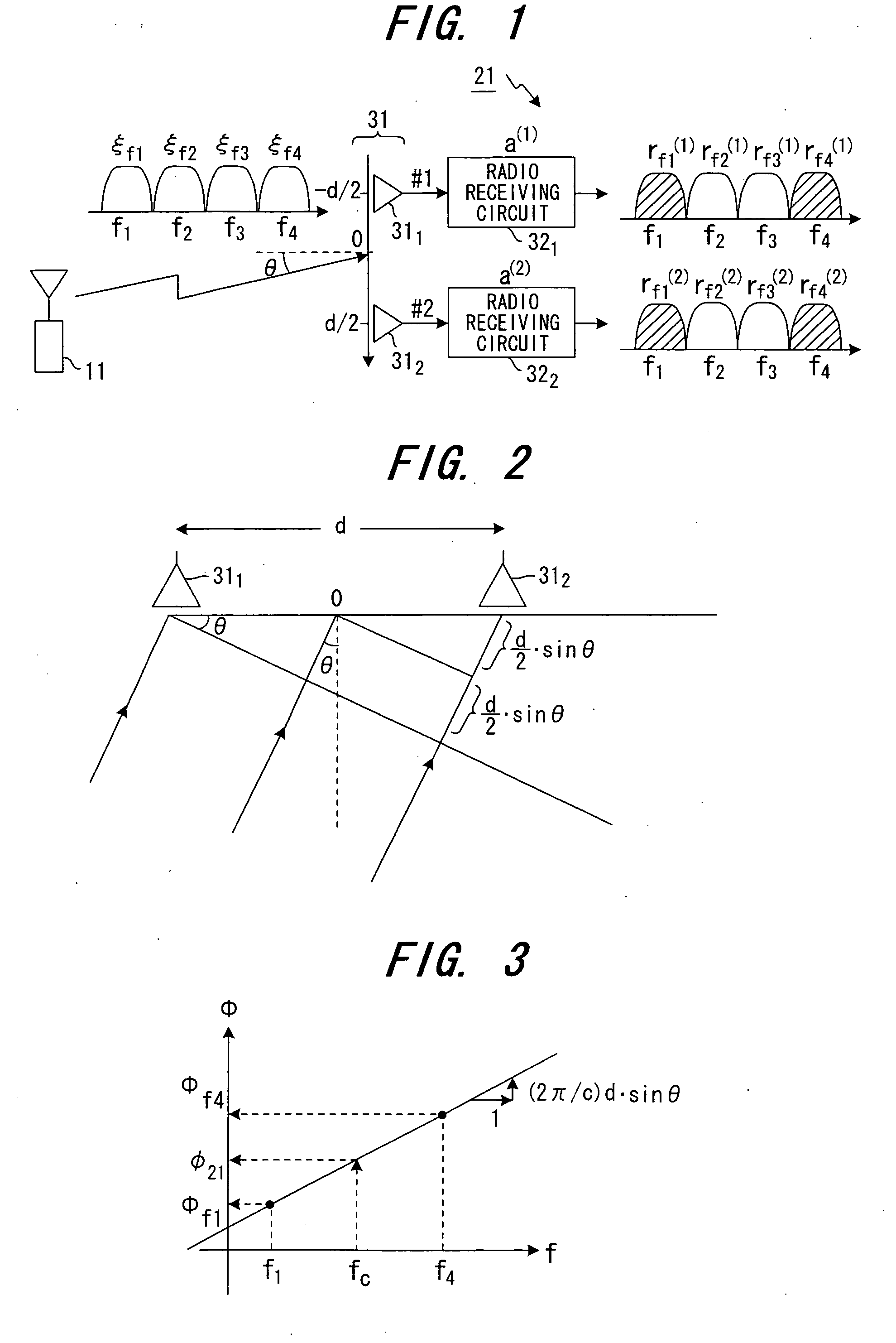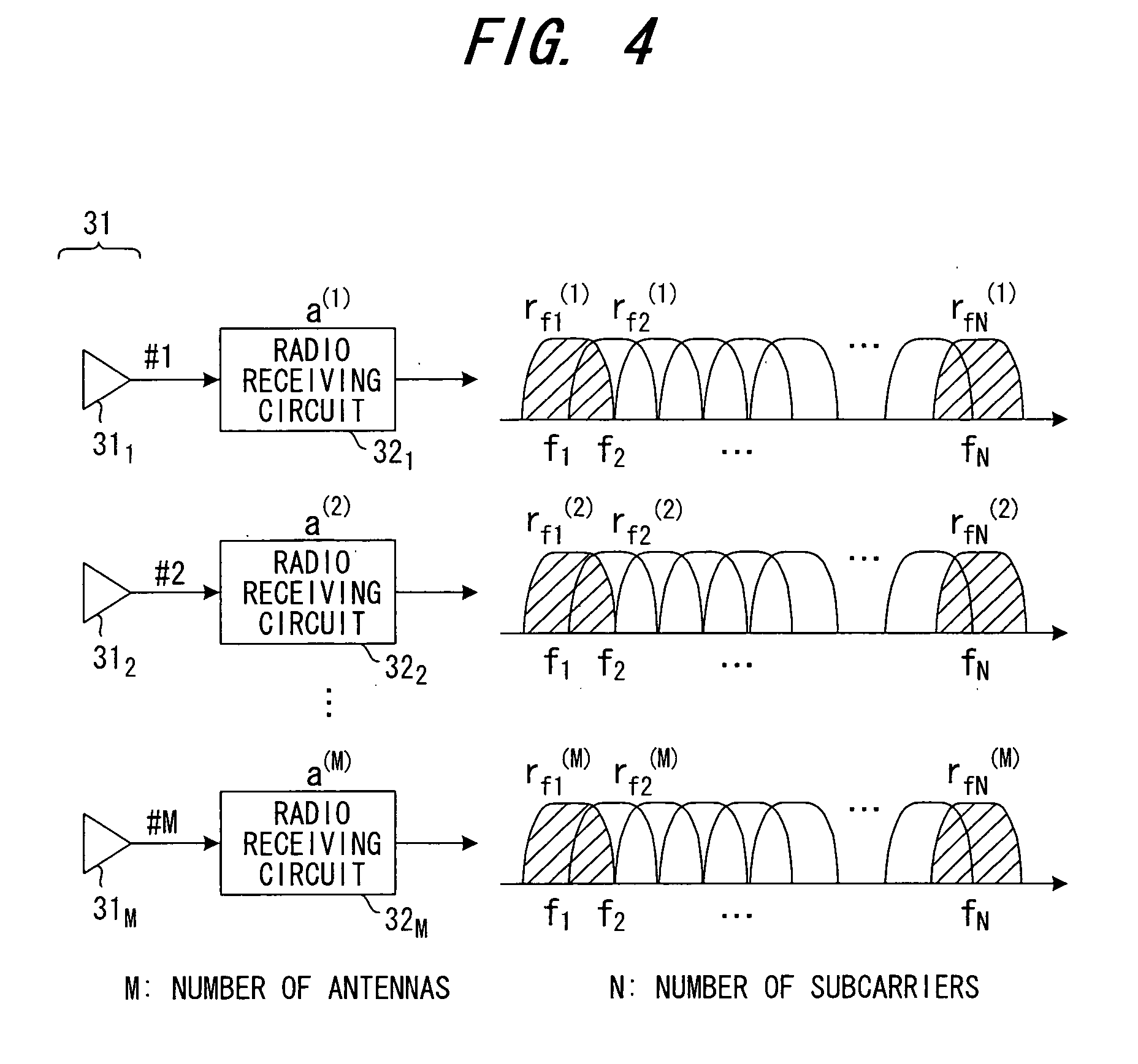Wireless communication apparatus and phase-variation correction method
a communication apparatus and phase-variation correction technology, applied in electrical apparatus, radio transmission, substation equipment, etc., can solve the problems of limiting the number of channels that can communicate simultaneously, limiting the capacity of channels, and estimation cannot be accurately performed, so as to improve the accuracy of phase-variation estimation, improve reception accuracy, and improve the effect of reception accuracy
- Summary
- Abstract
- Description
- Claims
- Application Information
AI Technical Summary
Benefits of technology
Problems solved by technology
Method used
Image
Examples
first embodiment
[0054] (B) First Embodiment
[0055]FIG. 5 is a diagram illustrating the structure of a radio receiving apparatus according to a first embodiment of the present invention. Components identical with those of FIGS. 1 and 4 are designated by like reference characters.
[0056] The mobile station 11 wirelessly transmits a multicarrier signal of frequencies f1 to fN. The radio waves (beams) of this radio signal impinge upon the linear array antenna (where the number of antennas is M) 31 of the base station 21 at an angle θ. Antennas 311 to 31M of the array antenna input the received signal to radio receiving circuits 321 to 32M, respectively. The radio receiving circuits 321 to 32M amplify the respective radio signals, subject the radio signals to frequency down-conversion processing and AD conversion processing and output baseband signals of the combined N-number of carriers. Narrow-band-signal extracting units 331 to 33M respectively separate and output signal components rf1(1) to rfN(1); r...
second embodiment
[0063] (C) Second Embodiment
[0064]FIG. 6 is a diagram illustrating the structure of a radio receiving apparatus according to a second embodiment of the present invention. Components identical with those of FIGS. 1 and 4 are designated by like reference characters.
[0065] The mobile station 11 wirelessly transmits a multicarrier signal of frequencies f1 to fN. The radio waves (beams) of this radio signal impinge upon the linear array antenna (where the number of antennas is M) 31 of the base station 21 at an angle θ. The antennas 311 to 31M of the array antenna input the received signals to the radio receiving circuits 321 to 32M, respectively. The radio receiving circuits 321 to 32M amplify the radio signals, subject the radio signals to frequency down-conversion processing and AD conversion processing and output baseband signals of the combined N-number of carriers. Narrow-band-signal extracting units 411 to 41M respectively separate and output the signal components rf1(1), rfN(1);...
third embodiment
[0081] (E) Third Embodiment
[0082] The foregoing embodiments relate to a case where a correction is applied upon estimating one of the phase-shift amounts φ(1) to φ(M) per each of the radio receiving circuits 321 to 32M. However, there are instances where in wide-band transmission such as OFDM transmission, the radio receiving circuits 321 to 32M have frequency characteristics and the phase-shift amounts θ fluctuate from one frequency band to another. In such cases it is necessary to obtain and correct the amount of phase shift on a per-frequency-band basis.
[0083]FIG. 12 is a diagram useful in describing the principles of a third embodiment of the present invention. Here OFDM subcarriers f1 to fN are partitioned into F-number of bands B1 to BF. In the case of OFDM, the number N of subcarriers is 128, 256, 512, etc.
[0084] The phase-variation & arrival-direction estimating unit 34 obtains phase-shift amounts φ(1)[1] to φ(M)[1]; φ(1)[2] to φ(M)[2]; . . . ; φ(1)[F] to φ(M)[F] in respec...
PUM
 Login to View More
Login to View More Abstract
Description
Claims
Application Information
 Login to View More
Login to View More - R&D
- Intellectual Property
- Life Sciences
- Materials
- Tech Scout
- Unparalleled Data Quality
- Higher Quality Content
- 60% Fewer Hallucinations
Browse by: Latest US Patents, China's latest patents, Technical Efficacy Thesaurus, Application Domain, Technology Topic, Popular Technical Reports.
© 2025 PatSnap. All rights reserved.Legal|Privacy policy|Modern Slavery Act Transparency Statement|Sitemap|About US| Contact US: help@patsnap.com



